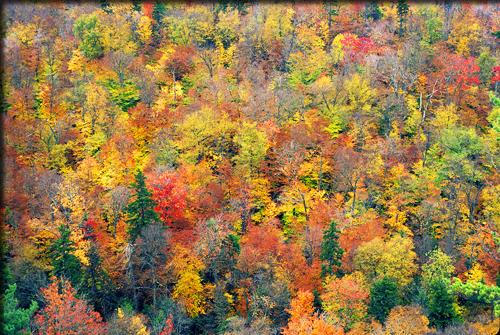Why Leaves Change Color
The Splendor of Autumn
Every autumn we revel in the beauty of the fall colors. The mixture of red, purple, orange and yellow is the result of chemical processes that take place in the tree as the seasons change from summer to winter.
During the spring and summer the leaves have served as factories where most of the foods necessary for the tree’s growth are manufactured. This food-making process takes place in the leaf in numerous cells containing chlorophyll, which gives the leaf its green color. This extraordinary chemical absorbs from sunlight the energy that is used in transforming carbon dioxide and water to carbohydrates, such as sugars and starch.
Along with the green pigment are yellow to orange pigments, carotenes and xanthophyll pigments which, for example, give the orange color to a carrot. Most of the year these colors are masked by great amounts of green coloring.
Chlorophyll Breaks Down
But in the fall, because of changes in the length of daylight and changes in temperature, the leaves stop their food-making process. The chlorophyll breaks down, the green color disappears, and the yellow to orange colors become visible and give the leaves part of their fall splendor.
At the same time other chemical changes may occur, which form additional colors through the development of red anthocyanin pigments. Some mixtures give rise to the reddish and purplish fall colors of trees such as dogwoods and sumacs, while others give the sugar maple its brilliant orange.
The autumn foliage of some trees show only yellow colors. Others, like many oaks, display mostly browns. All these colors are due to the mixing of varying amounts of the chlorophyll residue and other pigments in the leaf during the fall season.
Other Changes Take Place
As the fall colors appear, other changes are taking place. At the point where the stem of the leaf is attached to the tree, a special layer of cells develops and gradually severs the tissues that support the leaf. At the same time, the tree seals the cut, so that when the leaf is finally blown off by the wind or falls from its own weight, it leaves behind a leaf scar.
Most of the broad-leaved trees in the North shed their leaves in the fall. However, the dead brown leaves of the oaks and a few other species may stay on the tree until growth starts again in the spring. In the South, where the winters are mild, some of the broad-leaved trees are evergreen; that is, the leaves stay on the trees during winter and keep their green color.
Only Some Trees Lose Leaves
Most of the conifers – pines, spruces, firs, hemlocks, cedars, etc. – are evergreen in both the North and South. The needle- or scale-like leaves remain green or greenish the year round, and individual leaves may stay on for two to four or more years.
Weather Affects Color Intensity
Temperature, light, and water supply have an influence on the degree and the duration of fall color. Low temperatures above freezing will favor anthocyanin formation producing bright reds in maples. However, early frost will weaken the brilliant red color. Rainy and/or overcast days tend to increase the intensity of fall colors. The best time to enjoy the autumn color would be on a clear, dry, and cool (not freezing) day.
Enjoy the color, it only occurs for a brief period each fall.
Text prepared by Carl E. Palm, Jr. …as featured on weather.com
Related Posts:
8 Plants For Winning Fall Color In Your Garden
The 3 Best Things You Can Do For Your Lawn This Fall
Remember, Allentuck Landscaping Company is always here to help you design, install, construct and maintain you lawn and landscape. Give us a call!
Allentuck Landscaping Company is Your Residential Landscape Company
Phone: 301-5-515-1900 Email: info@allentucklandscaping.com
At Allentuck Landscaping Company, our mission is to create beautiful environments for people to enjoy. We see landscaping as a way to improve people’s lives.
The Allentuck Landscaping Company team has been delighting homeowners in Maryland, Washington DC and Northern Virginia for over 28 years with our turnkey approach to landscape design, installation, construction and maintenance. Most companies try to serve many types of customers at the same time; homeowners, shopping centers, office buildings and the list goes on. At Allentuck Landscaping Company, we focus on one customer, you, the homeowner. We have a singular focus on bringing you the best landscape practices, the best customer service, and the best value for your home.
Services Provide – Master Landscape Plans, Complete Maintenance Programs, Plantings, Patios, Walkways, Retaining Walls, Water Features, Outdoor Lighting, Outdoor Kitchens, Trellises & Pergolas, Irrigation Systems, Drainage Solutions, Grading & Sodding. Fire Pits & Fire Places, Spring Clean Ups, Decks, Fences
Areas Served – Chevy Chase, Bethesda, Potomac, Rockville, North Potomac, Darnestown, Gaithersburg, Germantown, Boyds, Clarksburg, Ijamsville, Urbana, Frederick and Washington DC.

